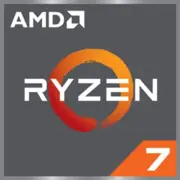AMD Ryzen 7 PRO 1700

AMD Ryzen 7 PRO 1700: Comprehensive Review of the 2025 Processor
April 2025
Key Specifications: Zen Architecture, 14 nm, and Balance of Performance
The AMD Ryzen 7 PRO 1700 processor, released in 2017, remains in demand in 2025 due to its unique combination of features.
Architecture and Process Technology
- Codename: Summit Ridge.
- Architecture: Zen (first generation).
- Process Technology: 14 nm (GlobalFoundries).
- Cores/Threads: 8/16.
- Base/Boost Frequency: 3.0 GHz / 3.7 GHz (Precision Boost).
- Cache: L3 — 16 MB, L2 — 4 MB.
- TDP: 65 W.
Performance
- Geekbench 6: 1011 (Single-Core), 4937 (Multi-Core).
- Cinebench R23: ~1100 (Single), ~9800 (Multi).
- Real-World Tests: Rendering in Blender (BMW scene) completes in ~14 minutes, comparable to the Ryzen 5 5500.
Key Features
- PRO Functions: AMD GuardMI (malware protection), remote management support (DASH).
- Multithreading: 16 threads for parallel tasks.
- Energy Efficiency: TDP of 65 W compared to 95–105 W for competitors (e.g., Intel i7-8700K).
Compatible Motherboards: AM4 Socket and Chipset Selection
The Ryzen 7 PRO 1700 uses the AM4 socket, providing flexibility in building.
Recommended Chipsets
1. B350/X370: Budget boards (ASUS Prime B350-Plus, MSI X370 Gaming Pro Carbon).
- Overclocking support (but limited VRM).
- Price example (new stock): $60–$90.
2. X470/B450: Optimal choice (ASRock X470 Taichi, Gigabyte B450 Aorus Pro).
- Enhanced VRM and PCIe 3.0 x16.
- Price: $80–$120.
Selection Features
- BIOS Update: A firmware update may be required for the Ryzen 7 PRO 1700 to work on newer boards (e.g., B450).
- VRM: A board with heat sinks on power phases is needed for stable operation of the 8-core CPU (avoid cheap A320).
Memory: DDR4 and Tuning Tips
The processor supports DDR4 (not compatible with DDR5).
Recommendations
- Frequency: Officially up to 2666 MHz, but many boards can operate with 2933–3200 MHz (overclocked).
- Dual-Channel Mode: It is essential to use 2 or 4 modules.
- Examples: Kingston HyperX Fury 3200 MHz (16 GB) kits — $45–$60.
Real-World Experience: Setting timings to 16-18-18-36 (for 3200 MHz) provides a 5–7% performance boost in work applications.
Power Supply: Power Calculation
With a TDP of 65 W, the processor is not demanding on the PSU, but it's important to consider other components.
Scenarios
- Office PC (without discrete GPU): 350–400 W (e.g., be quiet! Pure Power 11 400W — $55).
- Gaming Build (RTX 3060): 550–650 W (Corsair CX650M — $75).
- Workstation (NVIDIA Quadro): 750 W (Seasonic Focus GX-750 — $120).
Tip: Don't skimp on certifications (80+ Bronze or higher).
Pros and Cons: Why Is It Relevant in 2025?
Pros
- Price: New units — $120–$150 (2.5 times cheaper than Ryzen 5 7600X).
- Multithreading: 16 threads for rendering, virtualization.
- Energy Consumption: Suitable for quiet and compact builds.
Cons
- Outdated Architecture: Lags in single-core performance compared to budget Ryzen 5 5500 (Geekbench 6 SC — 1450).
- No PCIe 4.0: Limitation for SSDs and new GPUs.
- Upgrade Challenges: AM4 no longer supports newer processors.
Use Cases: Where the Potential Unfolds
1. Work Tasks:
- Video editing in DaVinci Resolve, 3D modeling (SolidWorks).
- Virtualization (VMware Workstation, 3–4 simultaneous OS).
2. Multimedia:
- Streaming (OBS + x264 medium quality).
- Photo editing in Lightroom (batch correction).
3. Gaming:
- Older titles (Cyberpunk 2077 on medium settings — 45–55 FPS with RX 6600).
- Online games (CS2, Dota 2 — 100+ FPS).
Limitations: In games focused on single-core performance (e.g., Microsoft Flight Simulator 2024), FPS may drop to 30.
Comparison with Competitors: Intel and AMD
1. Intel Core i7-8700K (6C/12T):
- Pros: Better single-threaded performance (Geekbench 6 SC — 1250).
- Cons: Higher TDP (95 W), no ECC memory support.
- Price (new): $180–$200.
2. AMD Ryzen 5 5500 (6C/12T):
- Pros: Zen 3, PCIe 4.0.
- Cons: Only 6 cores.
- Price: $130–$140.
Conclusion: The Ryzen 7 PRO 1700 excels in multithreaded scenarios but falls short in current tasks.
Practical Build Tips
1. Motherboard: Choose X470/B450 with USB 3.1 Gen2 support (e.g., MSI B450 Tomahawk Max).
2. Cooling: The stock cooler is sufficient, but for quiet operation — DeepCool AK400 ($30).
3. Memory: 32 GB DDR4-3200 (2x16 GB) is optimal for work tasks.
4. SSD: Samsung 870 Evo (SATA) or Kingston NV2 (PCIe 3.0) — for budget savings.
Example Build (price ~$400 without GPU):
- CPU: Ryzen 7 PRO 1700 ($130).
- Motherboard: ASRock B450 Steel Legend ($90).
- Memory: TeamGroup Vulcan 32 GB DDR4-3200 ($70).
- PSU: EVGA 600 BR ($65).
Final Conclusion: Who Is Ryzen 7 PRO 1700 Suitable for in 2025?
This processor is worth considering for:
- Budget professionals: For rendering, editing, or server tasks.
- Enthusiasts breathing new life into hardware: Building a PC from affordable components.
- Office users: Low power consumption and reliability.
Why not the Ryzen 5 5500? If parallelism is crucial, the 8 cores of the PRO 1700 perform better. However, for gaming and everyday tasks, modern CPUs are preferable.
In summary: The Ryzen 7 PRO 1700 is not a performance king, but it is a reliable choice for niche tasks. Its price and reliability keep it relevant even eight years after release.
Basic
CPU Specifications
Memory Specifications
GPU Specifications
Miscellaneous
Benchmarks
Compared to Other CPU
Share in social media
Or Link To Us
<a href="https://cputronic.com/index.php/cpu/amd-ryzen-7-pro-1700" target="_blank">AMD Ryzen 7 PRO 1700</a>